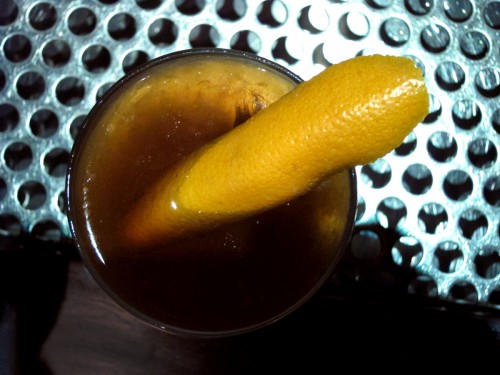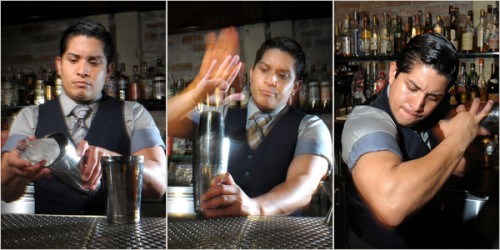Those of you who’ve been reading this babble for years on end (all nine of you!) may remember my having mentioned The Fat Pack in passing here and there. The Fat Pack consists of some close friends who are mostly if not entirely New Orleans fanatics and food fanatics, especially when it comes to pork, and especially when it comes to bacon. “Make mine bacon-wrapped” is our unofficial motto; the Latin version, “Fac meum lardo involvit” (I think) will be one of the mottos on our personal coat of arms, if Wes and I ever get around to designing one. (The other will be “Bibo ergo sum.”)
The Fat Pack has also had a tradition for many years — Second Thanksgiving. This takes place on the Sunday of Thanksgiving weekend, three days after the official holiday. The primary motivation behind it is to 1) see each other on the holiday weekend, 2) have a massively fattening and indulgent meal, usually fraught with bacon, and which includes 3) no family drama. It’s pretty much always a raging success.
Over the years I’ve also really enjoyed getting different circles of our friends together, and this year was one of the best of those meetups, achieving a critical mass of food and good times that I think will undoubtedly carry on into the future. Our friend Robb, who had met very few of the Fat Pack folk before, came along with us to Second Thanksgiving this year and brought along two dishes that flipped everyone’s lids. Of course, they would have loved him anyway, ’cause he’s a great guy, but those two dishes certainly cemented that love. The first dish he unveiled was a gorgeous from-scratch mac ‘n cheese (oricchiette, to be precise) laden with applewood-smoked bacon … delicious, but almost too easy. Okay, we love bacon, and THANK YOU! … but what else ya got?
Well, what else he had was this, and it blew everyone away.
Robb’s been experimenting with homemade marshmallows recently. If you’ve ever done them, you’ll know that they’re actually pretty easy, and about eleventy million times better than what you get out of the plastic bags from the grocery store. Basically it’s just four ingredients — cold water, gelatin, sugar and corn syrup — plus a pinch of salt and some confectioners’ sugar and potato starch for dusting. Easy peasy. But … there’s a lot you can do with that. You can easily add flavorings, fruit purées … just swap out part of the liquid content (i.e., the water) for the liquid or purée you’re adding, and bloom the gelatin on that as you would if it were just water.
The first batch Robb made were strawberry marshmallows, made from strawberry purée (fresh or frozen, and strained). In addition to the powdered sugar/potato starch dusting on the outside, the original recipe called for freeze-dried strawberries — Robb found a relatively new Trader Joe’s product packaged as a snack — pulverized and resulting strawberry powder added to the sugar and cornstarch mixture. What a perfect touch.
For his next batch, he began thinking along the lines of the holidays. What fall and winter flavors do we like, and what do we like for dessert on Thanksgiving? Pumpkin pie comes to mind immediately, so that became Robb’s next experiment, based upon the strawberry marshmallow recipe he’d found.
The results of that experiment — orange-tinted, squooshy, pumpkiny magic.
The had an amazing pumpkin-spice flavor, and were just as light as any other marshmallow. Delicious as they were right out of hand, when Nettie said, “Hey, let’s stick these on forks and toast them over the gas flame” … well, our heads pretty much exploded at that point. These are great marshmallows, but toast them over an open flame and they’re INSANELY great marshmallows.
Robb was kind enough to share the recipe with us. When you make these at home and boggle your family, make sure you give credit where credit is due!
(Unfortunately, everyone nomnomnommed these marshmallows so quickly that by the time anyone thought to take a picture of them, they were gone, alas.)
SPICED PUMPKIN PIE MARSHMALLOWS
(Recipe adapted by Robb Briggs)
4 envelopes unflavored gelatin
2/3 cups canned pumpkin purée
1-1/4 cups water
3 cups sugar
1-1/4 cups light corn syrup
1/4 teaspoon salt, about
1-1/2 teaspoons pumpkin pie spice (adjust to taste), plus more for dusting
Powdered sugar and potato starch or rice flour for dusting
Line a 9×13 baking pan with aluminum foil (I prefer a pan with sharp corners, so you don’t get rounded corner marshmallows). If you want thinner marshmallows that you can cut with cookie cutters, use a sheet pan. Coat the foil with vegetable oil or non-stick spray. Fit the mixer with the whisk attachment.
In the bowl of a stand mixer, mix the pumpkin puree and 1/2 cup of the water. Sprinkle the gelatin over this mixture to bloom, or soften. (I actually mix the gelatin in, it seems to work better for me.)
In a heavy saucepan, combine the sugar, corn syrup, remaining 3/4 cup water and salt. Bring to a boil and cook until it reaches the soft-ball stage (234-240°F).
With the mixer at full speed, pour all of the hot syrup slowly down the side of the bowl. Be careful as the mixture is very liquid and hot at this point and some may splash out — use a splash guard if you have one. Whip until the mixture is very fluffy and stiff, about 8-10 minutes. Lower the speed and add the pumpkin pie spice, and let it run for a few seconds, until the spice is fully mixed in. Pour mixture into the foil-lined pan and smooth with an oiled offset spatula. Allow the mixture to sit, uncovered at room temp for 10 to 12 hours.
Mix equal parts powdered sugar and potato starch (about 1/3 cup of each), and add 1/4 to 1/2 teaspoons pumpkin pie spice, and sift generously over the rested marshmallow slab. Turn it out onto a cutting board or counter, peel off foil and dust with more sugar/starch mixture. Slice with a thin-bladed oiled knife or oiled cookie cutters or a pizza cutter. Dip all cut edges in sugar/starch mixture and shake off excess. Marshmallows will keep several weeks at room temperature in an air-tight container.
P.S. — Before the year is out, I’ll have made boozy marshmallows. Stay tuned.


![]](http://looka.gumbopages.com/wp-content/uploads//IMG_0798-500x386.jpg)





